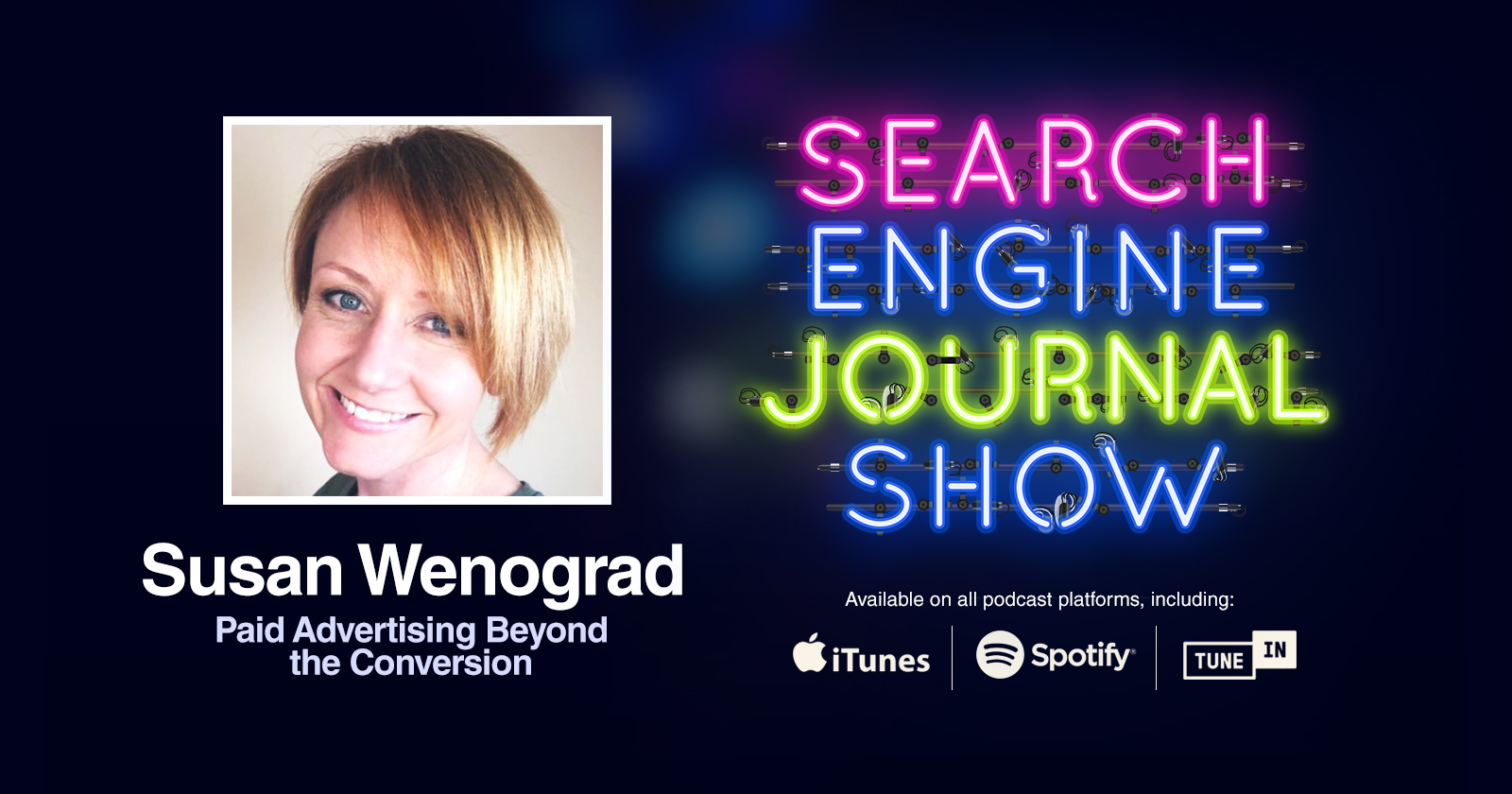Podcast: Download
Subscribe: Apple Podcast Google Podcasts Spotify
For episode 197 of The Search Engine Journal Show, I had the opportunity to interview Susan Wenograd, Chief Marketing Officer at Aimclear, as well as PPC Reporter at Search Engine Journal.
Wenograd, who’ll also be speaking at the SEJ eSummit on June 2, discusses how to incorporate and understand paid advertising beyond the conversion.
![Paid Advertising Beyond the Conversion with Susan Wenograd [PODCAST]](https://www.searchenginejournal.com/wp-content/uploads/2020/05/paid-advertising-beyond-the-conversion-with-susan-wenograd-podcast--5ece596b4e322.png)
What actually is there beyond the conversion for PPC marketers to actually look at and find value in?
Susan Wenograd (SW): Because we all started pretty much with paid search, and that’s such a bottom of funnel tactic, we’ve just been conditioned to evaluate everything that way.
So even amongst the channels themselves, there’s been that push and pull about how do we evaluate these channels.
The fact of the matter is the targeting that’s available on a lot of them exists specifically to not necessarily be at that conversion point.
So when you’re thinking about the channels that you’re working with, just like you’re really thinking about anything else in your full marketing stack, you have to evaluate them on their own merits.
So if you’re running something on Facebook, yes, you’ll probably get conversions from it, especially if you have it set up to optimize that way.
But you’re also probably reaching a lot of people that might not buy now, but they’re still in the future a good audience for you.
You’ll still find a lot of brands and advertisers that will look at it and say, “Well, Facebook doesn’t do as well as Google Search,” or, “It doesn’t do as well as this,” or, “It does better than that.”
It’s comparing apples to oranges. A lot of times, they’re not meant to do the same thing. The users are not at the same process.
They’re not in the same process as far as how close they are to buying or where they are in awareness.
So there’s this ongoing continuum of where people are as far as if they need what you sell, if they understand what you sell, if they can afford what you have.
They’re all along this continuum, and so to go in and say, “We’re just spending this money to get these conversions,” is pretty short-sighted.
Brent Csutoras (BC): I would say the majority of ad dollars doesn’t have a conversion on it. Like when you see a billboard with Nike, when you see a commercial, where do you “buy now”?
There is now “Buy Now.” So much of marketing is long-term conditioning and influence, and so to say that it all comes down to one point and you don’t care about anything else, it just felt so disconnected from everything we had come to learn in marketing.
SW: One of the things that we’ve really seen heavily, especially the past two years, was how difficult it was getting from a direct-to-consumer perspective to get people to convert the way they used to.
We saw this really big on Facebook and definitely in some pockets on Google where there was so much reliance on just it being, like you said, it was the magic money machine.
It’s what I always call it, where it’s like, “Well, I put in $2, and so I have to make $10.”
The thing is that’s not a sustainable marketing strategy.
It’s not how you’re going to grow your brand, and so the short-sightedness of that I think is you’re finally was coming home to roost where people are realizing, “You know, there is value in something like a billboard. There is value in television commercials.”
But everyone thought that because you couldn’t draw a straight line from point A to point B, they just had no value.
I think a lot of advertisers forget that the competition thing is a lot more obvious in paid search.
In paid social, it’s a little different just from how I’ve seen brands and advertisers react.
They just operate a little more methodically about it where they’re just like, “Well, I always used to get a 500% return, and now I’m not. What’s going on?”
So I had worked with a large brand that spent six figures a month, and it was direct-to-consumer, but they were in a competitive industry.
They weren’t the cheapest, and they were continually frustrated that their results were so much easier a year before.
The other thing that happens too is that because you’re just focusing on people that are likely to buy or likely to convert, you’re not building your pipeline.
So you become solely reliant on people that are at the buying stage, and you’re not actually creating any demand or creating any brand awareness so that you’re top of mind when that happens.
It seems like it should be Marketing 101, right? It’s like if you take any marketing course, you have these stages to purchase.
But with paid, because everyone was so conditioned to looking at the data and saying, “OK. When I put money here, this is how much I make,” everyone just forgot about how to market, and no one wanted to spend the money on things that they didn’t feel was driving a direct conversion.
No one wanted to look at things like an incremental lift or incremental brand search.
No one wanted to look at that stuff because they didn’t have to.
So what’s become interesting now is I do feel like the smart brands and advertisers are realizing that they’re not building a brand when they do that…
It’s like the second they stop spending money, they have no sales. You don’t own a brand if that happens. Like you really don’t have much of a business.
BC: Well, I think that the other aspect you really have to consider is storytelling, right?
I think that’s what happens a lot of times over the last probably three or four years specifically with paid is that we’ve seen this transition from SEO, from paid, from everything because storytelling has shifted significantly.
Brands are really shining is where they’re understanding where that storytelling goes.
I’m guessing that paid search isn’t gone. It’s just that paid search and especially a lot of the paid search I’ve been involved with lately hasn’t been about a conversion.
It’s been about continuing that storytelling.
SW: Yeah, and Google really has made nods and strides toward that with the in-market audiences that you can add as layers to your search campaigns and bid on them differently.
They’ve definitely pivoted more. They’ve had all these data for a while, and the effectiveness of some of it was hit or miss.
But I feel like ever since we’ve been able to have these audience layers and used the stuff that we traditionally would use and display to apply it to search, they really started doing a better job of integrating that behavioral piece to supplement what you’re doing so it’s not just all about the search.
It does start accounting for those things of:
- Who are these people?
- Where are they in their journey?
- What do they care about?
Because that’s the other piece is that even though people might search for the same words, it doesn’t mean that they need the same things.
How do I have to approach paid advertising if conversion is not what I’m going for?
SW: That is still usually the most difficult part, especially for things that have longer sales cycles.
A lot of times, the higher value product you’re selling, the higher money you’re going to have to pay to move that person along the purchase path.
So that’s where those conversations about goals that have to do with behavior on your site, or other behaviors, or micro-conversions that people can do along the way become more important because you want users to self-select into being in the group that you know you want to be targeting if that makes sense.
So for example, if you do something like a white paper download or a case study, or a checklist giveaway, or whatever those things are, those are not ultimately the conversion you’re looking for, but they’re signals that you’re reaching the right people.
If you spend money, and drive 2,000 people to a landing page, and no one downloads anything, then you know, “OK. This is probably not the people that I really want to be reaching.”
So it becomes about thinking backward…
I always call it getting people to raise their hand to be like, “Yes, I am the person you’re looking for,” because it’s not always going to be in terms of just a purchase.
Something like LinkedIn is a really good example of that, especially when you get into these high-value, but also high-dollar stakes.
There are have been so many brands that I’ve worked with, especially in B2B where LinkedIn has that targeting that they need, but they say, “It’s really expensive, and we’ve tried it. Nothing happened.”
A lot of times, what winds up happening is they’re driving them to a software product that’s thousands of dollars, and they’re like, “Well, no one signed up.”
So you’re trying to go from zero to 60 way too quickly. So that’s when you have to have those kinds of conversations about…
If you look in Salesforce or whatever [CRM] it is you’re using, there’s probably an average number of times that someone has contacted or visits your site, or whatever it is they do before they even become a prospect let alone someone that’s going to buy.
So you can’t hold paid platforms responsible for things that they can’t possibly do because that doesn’t happen anywhere else in your business.
It’s like what you were saying before. There’s this weird expectation that all marketing rules don’t apply to paid and they should just sell things.
One of the things that I try and work with customers on is getting into this mindset that it’s not about just getting them to click and to buy right away.
At this point, there are so many audiences. There are so many ways to target people. You need to start just creating buckets of audiences that you can continue to talk to.
I don’t want to just run everywhere forever and hope I get sales off of it.
I want to carve off all the people that aren’t really the people I’m looking for, and then just focus on those with the rest of my spend.
In the LinkedIn example, if you’re spending $16, $20 something, $30 something a click, given their prices, you don’t want to be that brand that’s like, “Well, we spent that money and nothing happened.”
Nine times out of 10, when I look at the strategy, there was no strategy other than to just drive them to the site, or they’re like, “We got all these white paper downloads, and then nothing happened,” because it’s not about the paid media doing all that for you.
There has to be something that happens after that. If you’re spending that much money, you were buying an audience.
You have to look at it as though you were buying that audience so you can continue to market to them, but so many companies don’t do that.
This podcast is brought to you by Ahrefs and Opteo.
To listen to this Search Engine Show Podcast with Susan Wenograd:
- Listen to the full episode at the top of this post
- Subscribe via Apple Podcasts
- Sign up on IFTTT to receive an email whenever the Search Engine Journal Show RSS feed has a new episode
- Listen on Spotify, TuneIn, Stitcher or Overcast
Visit our podcast archive to listen to other Search Engine Journal Show podcasts!
Image Credits
Featured Image: Paulo Bobita




